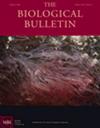参与海葵刺丝囊排出的trpv样离子通道的功能表征
IF 1.9
4区 生物学
Q2 BIOLOGY
引用次数: 0
摘要
刺胞动物需要机械刺激来触发刺丝囊排出并启动进食行为。从触发刺激到反应的间隔是几十微秒,这使得机械门控离子通道很可能触发刺丝囊放电。由于许多瞬时受体电位通道是机械门控的,我们假设线囊放电涉及瞬时受体电位通道。因此,我们测试了各种瞬时受体电位通道抑制剂,以确定它们是否能抑制裸眼海葵(Actinaria) Diadumene lineata(又名halilplanella luciae)的刺丝囊排出和猎物杀死。三种类型的刺丝细胞支持细胞复合物调节海葵中刺丝囊的放电:C型,B型和a型C型的放电由接触敏感机械感受器的刺激直接触发,而B型则需要从猎物衍生的n -乙酰化糖中激活化学感受器来使接触敏感机械感受器敏化。在a型中,活化的化学感受器调节振动敏感的机械感受器,使接触敏感的机械感受器易于触发。非选择性瞬态受体电位通道阻滞剂镧和钆剂量依赖性地抑制约80%的猎物捕杀和所有b型和c型线虫囊放电,但不抑制a型线虫囊放电。选择性瞬时受体电位香草素4 (TRPV4)阻滞剂GSK2193874可抑制a型和b型。然而,选择性TRPV4阻滞剂HC-067047和RN-1734仅抑制a型。因此,三种trpv4选择性阻滞剂与trpv样参与a型放电有关,而GSK2193874也影响b型放电。我们的研究结果表明,trpv样同源物在线虫囊介导的a型猎物杀伤中起重要作用,而其他瞬时受体电位通道可能参与B型和C型刺胞细胞支持细胞复合物的放电。本文章由计算机程序翻译,如有差异,请以英文原文为准。
Functional Characterization of TRPV-Like Ion Channels Involved in Nematocyst Discharge from the Sea Anemone Diadumene lineata
Cnidarians require mechanical stimuli to trigger nematocyst discharge and initiate feeding behaviors. The interval from triggering stimulus to response is tens of microseconds, making it likely that mechanically gated ion channels trigger nematocyst discharge. Because many transient receptor potential channels are mechanically gated, we hypothesized that nematocyst discharge involves transient receptor potential channels. We therefore tested various transient receptor potential channel inhibitors to determine whether they inhibit nematocyst discharge and prey killing in the acontiate sea anemone (Actinaria) Diadumene lineata (a.k.a. Haliplanella luciae). Three types of cnidocyte supporting cell complexes regulate nematocyst discharge in anemones: Types C, B, and A. Discharge from Type Cs is directly triggered by stimulation of contact-sensitive mechanoreceptors, while Type Bs require activation of chemoreceptors from prey-derived N-acetylated sugars to sensitize contact-sensitive mechanoreceptors. In Type As, activated chemoreceptors tune vibration-sensitive mechanoreceptors that predispose contact-sensitive mechanoreceptors for triggering. The non-selective transient receptor potential channel blockers lanthanum and gadolinium dose-dependently inhibited about 80% of prey killing and all nematocyst discharge from Type Bs and Type Cs, but not Type As. The selective transient receptor potential vanilloid 4 (TRPV4) blocker GSK2193874 inhibited Type As and Type Bs. However, the selective TRPV4 blockers HC-067047 and RN-1734 inhibited only Type As. Thus, three TRPV4-selective blockers implicate TRPV-like involvement in discharge from Type As, whereas GSK2193874 also affected Type Bs. Our results suggest that a TRPV-like homolog plays an essential role in nematocyst-mediated prey killing from Type As, whereas other transient receptor potential channels are likely involved in discharge from Type B and C cnidocyte supporting cell complexes.
求助全文
通过发布文献求助,成功后即可免费获取论文全文。
去求助
来源期刊

Biological Bulletin
生物-海洋与淡水生物学
CiteScore
3.30
自引率
6.20%
发文量
47
审稿时长
6-12 weeks
期刊介绍:
The Biological Bulletin disseminates novel scientific results in broadly related fields of biology in keeping with more than 100 years of a tradition of excellence. The Bulletin publishes outstanding original research with an overarching goal of explaining how organisms develop, function, and evolve in their natural environments. To that end, the journal publishes papers in the fields of Neurobiology and Behavior, Physiology and Biomechanics, Ecology and Evolution, Development and Reproduction, Cell Biology, Symbiosis and Systematics. The Bulletin emphasizes basic research on marine model systems but includes articles of an interdisciplinary nature when appropriate.
 求助内容:
求助内容: 应助结果提醒方式:
应助结果提醒方式:


